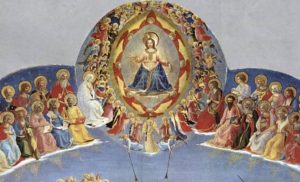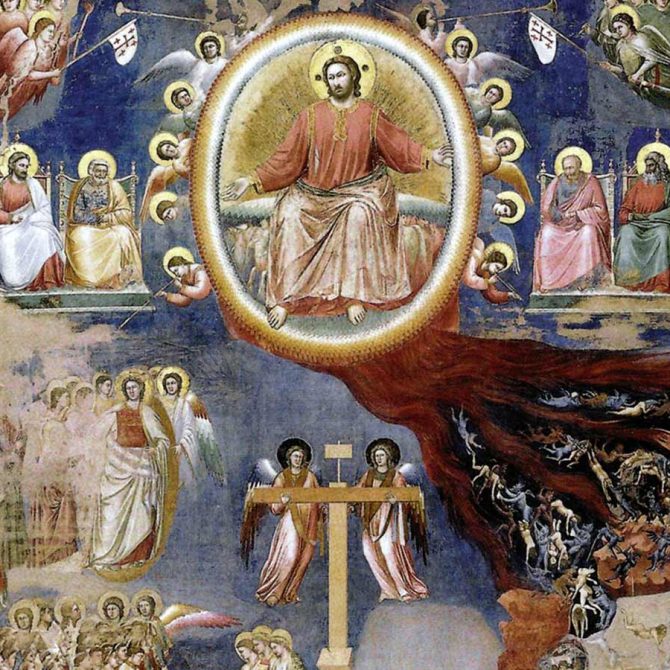This is the tenth in a series of articles on the Four Last Things: Death, Judgment, Heaven, and Hell.
 Continuing our series on the Four Last Things, in today’s post we consider an aspect of Heaven called the Communion of Saints. I have discovered that it is frequently misunderstood. Many of you know that I write the weekly “Question and Answer” column for the Our Sunday Visitor newspaper. Every once in a while, someone poses a unique question, one that I had never thought of before. such is the case with the question below. It led me to reflect on the deeper experience of what we call the Communion of Saints in Heaven.
Continuing our series on the Four Last Things, in today’s post we consider an aspect of Heaven called the Communion of Saints. I have discovered that it is frequently misunderstood. Many of you know that I write the weekly “Question and Answer” column for the Our Sunday Visitor newspaper. Every once in a while, someone poses a unique question, one that I had never thought of before. such is the case with the question below. It led me to reflect on the deeper experience of what we call the Communion of Saints in Heaven.
My answers are required to be no more than 600 words, so this response is relatively brief.
(There is an online catalogue of my “Question and Answer” columns available here: Msgr. Pope’s OSV Columns.)
Q: The descriptions in the Bible seem to describe a vast amount of people, and the paintings I have seen from the Renaissance make it look rather crowded and busy. Frankly, I hate big cities and crowds. Are these descriptions accurate or am I missing something? Doris Leben, Wichita, Kansas
A: The danger to avoid when meditating on Heaven is taking earthly realities and merely transferring them to Heaven. Even if there are similarities to things on earth, things in Heaven will be experienced in a perfected way, with unspeakable joy.
The more biblical and theological way to understand the multitudes in Heaven is not as a physical crowding but as a deep communion. In other words, the Communion of Saints is not just a lot of people walking about or standing around talking.
St. Paul teaches, So we, who are many, are one body in Christ, and individually members, one of another (Rom 12:5). Although we experience this imperfectly here on earth, we will experience it perfectly in Heaven. As members of one another we will have deep communion; we will know and be known in a deep and rich way. Your memories, gifts, and insights will be mine, and mine will be yours. There will be profound understanding and appreciation, a rich love and a sense of how we all complete one another and really are all one in Christ.
Imagine the glory of billions of new thoughts, stories, and insights that will come from being perfectly members of Christ and of one another. Imagine the peace that will come from finally understanding and being understood. This is deep, satisfying, and wonderful communion—not crowds of strangers.
Therefore, the biblical descriptions of Heaven as multitudes should not be understood as mere numbers, but as the richness and glory of communion. The paintings showing “crowds” should be understood as an allegory of deep communion, of being close in a way we can only imagine.
St. Augustine had in mind the wonderful satisfaction of this deep communion with God and with one another in Christ when he described Heaven as Unus Christus amans seipsum (One Christ loving Himself). This is not some selfish Christ turned in on Himself. This is Christ, the Head, in deep communion with all the members of His Body, and all the members in Christ experiencing deep mystical communion with Him and with one another—together swept up into the life of the Trinity. As St. Paul says, you are Christ’s, and Christ is God’s (1 Cor 3:23).


This deep communion is one of the most terrifying aspects of heaven to those who have not made peace with God, with themselves, and with others about their sins. It is one thing to go to confession and trust that one is forgiven, it is another thing to contemplate the full impact of *being known* by others when it comes to all sinful acts of omission and commission, especially where these might still be a habitual part of our selves. In heaven this shame will have been removed and all sins fully redeemed and purified, but contemplating this makes the value and necessity of purgatory that much more real to me.
I have thoroughly enjoyed this series on the four last things, and have learned a lot from them. You should consider compiling them into a book – if you haven’t already.